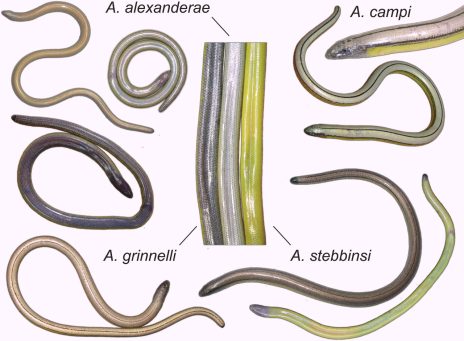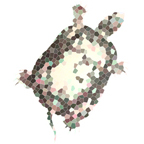Writing in the September 2013 issue of the Museum of Comparative Zoology, Harvard’s Breviora, California herpetologists Theodore J. Papenfuss and James F. Parham recently took the world by storm, enchanting news outlets across the globe with their discovery and description of four new species of California legless lizards.
Until recently, this unique lizard remained a relatively unheard-of reptile species (that is, outside of the small herpetological circle of Anniella initiates or those unknowingly lucky enough to live in an area where legless lizards are so common, they show up in the garden like earthworms). Nevertheless, California legless lizards are otherwise commonplace in central and southern California with sandy, loamy soils, oak trees, and lupines. Their namesake leglessness is an adaptation to a life spent underground, where they effectively swim through sandy soils, surfacing only to feed on insects beneath the leaf litter or short bursts of aboveground dispersal. Any resemblance to snakes is passing: legless lizard have moveable eyelids, vestigial limb rudiments, and autocaudal autonomony, the ability to lose their tails like common fence lizards.
After reporting a high genetic diversity amongst California legless lizards in 2009 (see Parham and Papenfuss 2009), Papenfuss and Parham delved deeper into Anniella spp. genetics to identify the contact zones between the emerging clades and determine whether these lineages were genetically isolated enough to recognize distinct cryptic species. After reviewing museum specimens as part of their 14-year range-wide study of genetic variation, Papenfuss and Parham found that coloration, one of the major morphological characters that helps distinguish the emerging Anniella complex, went largely unreported because the markings of specimens collected and preserved in alcohol became faded and degraded. Additional field study turned up live specimens whose coloration, paired with x-ray vertebral counts, stripe width, and scale counts, corroborated the researchers’ genetic variation.

Anniella alexanderae, upper left: dorsal and ventral view showing the diagnostic gray coloration. Anniella campi, upper right: dorsal view and detail showing diagnostic double dark lateral stripes. Anniella grinnelli, lower left: ventral view showing diagnostic purple coloration and dorsal view. Anniella stebbinsi, lower right: dorsal and ventral view. Center: comparison of ventral coloration from three of the new species: A. grinnelli, left, A. alexanderae, center, and A. stebbinsi. Image credit: Theodore Papenfuss / James Parham.
Here, briefly, are the four species nova:
Anniella alexanderae, new species
Temblor Legless Lizard
Key Diagnostic Characters: light grey ventral coloration; single lateral stripe; high (>250) dorsal scale count.
Distribution: sandy soils at the southeast base of the Temblor Range between McKittrick and Taft, west side of the Southern San Joaquin Valley, Kern County, CA.
Anniella campi, new species
Southern Sierra Legless Lizard
Key Diagnostic Characters: double, dark lateral stripes.
Distribution: western edge of the Mojave Desert in Kern and Inyo County, CA.
Anniella grinnelli, new species
Bakersfield Legless Lizard
Key Diagnostic Characters: purple (grayish red) ventral coloration.
Distribution: southern San Joaquin Valley and east side of the Carrizo Plain, CA.
Anniella stebbinsi, new species
Southern California Legless Lizard
Key Diagnostic Characters: karotype (cryptic).
Distribution: throughout southern California south of the Transverse Ranges into northern Baja California, Mexico; disjunct populations in the Tehachapi and Piute mountains, Kern County, CA.
With these new species comes another well-deserved honorific by naming the southern California legless lizard Anniella stebbinsi, a tribute to esteemed herpetologist Dr. Robert C. Stebbins.
These celebrated species may vanish as quickly as they’ve appeared, however. Given how easy it is to overlook these cryptic lizards, the limited distributions of three of them – the Temblor (A. alexanderae), Southern Sierra (A. campi), and Bakersfield (A. grinnelli) legless lizards – puts them at greater risk of extinction, especially where they overlap with human habitation. Papenfuss and Parham recommend further study to better understand the range and distribution of this newly described California-endemics.
Full Citation: Papenfuss, Theodore J. and James F. Parham. 2013. Four New Species of California Legless Lizards (Anniella). Breviora: September 2013, No. 536, pp. 1-17.


#1 by Don Stephens on September 23, 2013 - 12:02 am
I wonder how many more of these interesting lizards remain undiscovered, and how many have already been extripated, due to California’s intense agriculture…was there a Salinas variety that bit the dust to truck-garden farming?
– Don Stephens,
lay-herpetologist since the 1950s
#2 by cohendc on September 23, 2013 - 10:25 am
http://www.sfgate.com/default/article/4-new-species-of-legless-lizard-identified-4822729.php
this article, by David Perlman, appeared in the SF Chronicle on Wednesday Sept 18. Perlman is a national treasure whom we should all appreciate.
#3 by Shane M on February 9, 2014 - 1:43 pm
I stumbled upon this after finding, from what it looks like, Anniella Campi in my backyard! Never thought I’d find one while raking through soil!